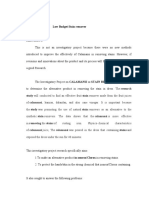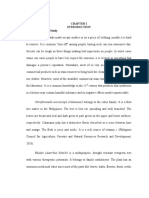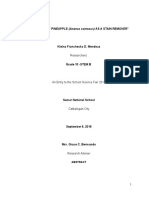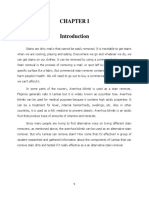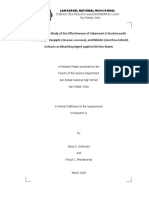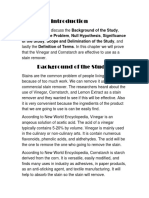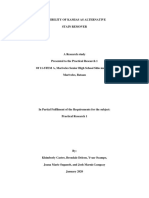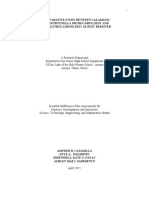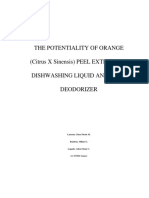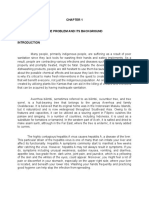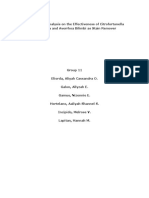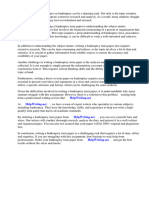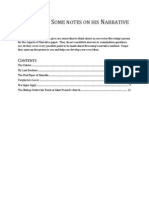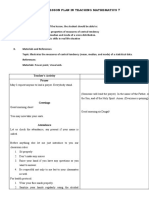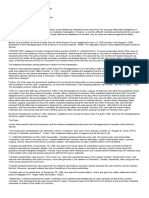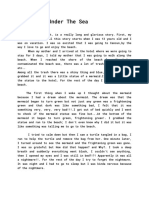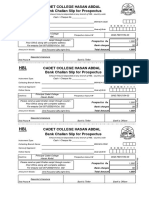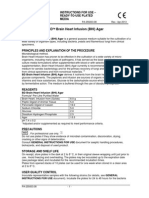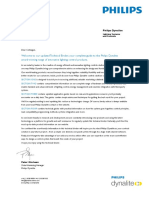CHAPTER I: THE PROBLEM AND THE BACKGROUND
Background of the Study
There are many dangerous chemicals in our surroundings most of them can be located
inside our own homes. Almost every household would contain stain remover like zonrox,
chlorine, otherwise why we decided to focus the investigatory project on creating an eco-friendly
cleaning solution.
If the stain remover for cleaning stains, which contains so much toxic, is used every day by
a lot of people then a large amount of glasses and waste from it can pollute the environment.
The group believes that the product can accomplish so much as well as being able to contribute
to the preservation of our planet. The scope and limitations in the project , the researchers plans
to make a stain remover that will benefit the people of the world plus the environment using only
juice a citrus fruit coming from its peeling and extract as its main ingredient. The specific fruits
that will be used for investigation is lemon and orange to kill and repel the stain.
The research study was conducted to find an effective fruit stain remover made from the
fruits of kalamansi and orange. It is important because the study was promoting the use of
natural stain removers as an alternative to the synthetic stain removers. It also provides
additional information about the potential of the kalamansi and orange extract as fruit stain
remover.
Kalamansi is a small, very round citrus fruit that’s ubiquitous in the Philippines. The fruits
are often used when the thin rind is still green on the outside, and that is the color associated
with it. The whole kalamansi fruit contains a small level of carbohydrates (3%), minerals (1%),
ascorbic acid (0.1%), and citric acid (3%). The peel is rich in essential oils and ascorbic acid
(0.15%). The juice is very acidic and contains 5.5% citric acid, while orange has only 0.6 to 1
percent of citric acid.
1
�Statement of the problem
This study aims to answer the following question:
1. Does the orange and lemon extract as an Alternative Stain Remover effective to remove
stain?
2. How much amount of stain can the calamansi and orange remove?
3. What are the advantages and disadvantages of using the extract of the orange and
lemon as an alternative stain remover?
Significance of the study
This study aims to help the student or people to help them protect their hands in chemicals. This
study will give knowledge to the people that the lemon and orange are not only in the fields of
foods but also in the fields of cleaning as an alternative stain remover in white clothes and eco-
friendly cleaning solution.
Scope and delimitations
This study will only focus on the effectiveness of the calamansi and orange extracts as an
alternative stain remover. It will try to identify the necessary procedures in order to produce an
outcome that will be good enough to serve as stain remover. This study will be conducted in
Villa Theresa Heights Ormoc City with the materials that are available within the vicinity. The
researchers will also focus on stain, so that it will create results that are acceptable.
2
� CHAPTER II: CONCEPTUAL FRAMEWORK
REVIEW OF RELATED LITERATURE
Some of the problems that we face during laundry are tough stains from catsup, blood, rust and
the like. These stains usually tarnish our clothes. It can also destroy the quality of the fabric
depending on the degree of stains. There are detergents and substances that remove stains.
However, many substances that will remove stains sometimes cause fabrics to deteriorate or
affect dye or finishes (Mendelson, 2005). Amidst the detergents and powders that we are
accustomed to using, there is a cheaper and practical alternative which will not only remove
stains but penetrate its nature and in the fabric.
Successful stain removal depends on three things: nature of the stain; type of fabric; and the
colorfastness of the dye (Cobb, 2001). These three things will determine whether a stain is easy
to remove or not. Stains that are easily removed have a nature that it doesn’t really penetrate
the fibers of the fabric. It only stays on the surface of the clothes and it only needs ordinary stain
removers. Meanwhile, stains that are difficult to remove needs a stronger stain remover since
the stain has imbedded itself inside the fibers and pores of the fabric. Difficult-to-remove stains
are stains that respond gradually. According to Mendelson (2005) “Some stains will respond
gradually so that you will have to apply your remedy a half dozen or more times before you are
completely successful”.
The most commonly used stain removers available in the market are bleaches, citrus fruits and
ordinary solvents. Ordinary solvents are also used as stain removal agents. The usual ordinary
solvent commonly used is water. Water is polar in nature and stains are usually combination of
both. Water attracts polar side of stains and removes the stain (Campbell and Farrell, 2009).
However, some stains are strong enough to remain in the fibers of the fabric. In order to remove
3
�those stains, these solvents are usually employed with detergents in hard stains such as oily or
greasy stains.
Citrus fruits are often employed as cleaning agents for stains, but in this study, we shall focus
on Calamansi (Citrofortunellamicrocarpa) and Lemon (Citrus limon) which are highly acidic
citrus fruits that contain citric acid.
Citric acids also have mild bleaching action useful for removing certain kinds of stains. Among
the fruit acids used in beverage, food, pharmaceutical, textile, metal, chemical and other
industries, Citric acid plays an exceptional role. Citric acid is commercially used and produced
worldwide. The acid widely occurs in variety of fruits and vegetables, especially in citrus fruits
(juice content 7-9%) and is responsible for their tart taste (Apelblat, 2014. p.1).
4
�CONCEPTUAL FRAMEWORK
INPUT PROCESS OUTPUT
1.)The number of 1.)Gathering Data 1.) The ability to
oranges(Citrus remove the
* Assessing the
sinensis) and different kinds of
number
calamansi stains using 3
oforanges(Citrus
(Citrofortunellami spoons of
sinensis) and
crocarpa) that will calamansi extract
calamansi
be utilized for the and 1 spoon of
(Citrofortunellami
experimentation. orange extract
crocarpa) to be
with the sum of a
used in the said
certain weight
experimentation
2.)As certain the
of the research. 2.) To determine
sum of the weight
the level of stains
of oranges(Citrus *
after the cloth
sinensis) and Experimentation
being soaked in
calamansi(Citrofo
* Quantify the the researcher’s
rtunellamicrocarp
total weight of productfor 5
a) that can
the orange(Citrus minutes
remove the
sinensis) and
different kinds
calamansi(Citrofo
and levels of
rtunellamicrocarp
stains.
a) extract in
order to remove
stains.
3.)Materialthat
are to be used in
the
experimentation
process.
5
�HYPOTHESIS OF THE STUDY
This study hypothesizes two outcomes:
H1:Oranges (Citrus sinensis) and calamansi (Citrofortunellamicrocarpa) is effective as
an alternative stain remover
H0:Oranges (Citrus sinensis) and calamansi (Citrofortunellamicrocarpa) is not effective
as an alternative stain remover
ASSUMPTION OF THE STUDY
Our fellow researchers (current or future) as this study may be able to guide
them if they are conducting a study with a similar topic. Their studies may become a
more updated version of this study. Thus, increasing the chances of new discoveries
and innovations, this will eventually lead to improvements and progress.
DEFINITION OF TERMS
Orange- oranges are round citrus fruits with finely-textured skins that are, of course,
orange in color just like their pulpy flesh; the skin can vary in thickness from very thin to
very thick.
Calamansi- is a small, very round citrus fruit that’s ubiquitous in the Philippines. The
fruits are often used when the thin rind is still green on the outside, and that is the color
associated with it.
6
�Extract- to carefully remove a substance from something which contains it, using a
machine, chemical process etc
Stain- a stain is a discoloration that can be clearly distinguished from the surface,
material, or medium it is found upon. They are caused by the chemical or physical
interaction of two dissimilar materials
Remover-a substance that removes something
7
� CHAPTER III: RESEARCH METHODOLOGY
Procedure used in the investigation of Project
Ingredients:
The measurement of the juice of calamansi and orange extract depends on the
container being used.
Ingredients:
Calamansi Juice
Oranges Juice
Equipments:
Kitchen knife
Plates
Small containers
Measuring spoon and measuring cups
Strainer
Clean cloth
Small jar
Chopping board
8
�Procedure:
1. Gather all the ingredients and equipments that are needed to use.
2. Cut all the calamansi and oranges using the kitchen knife and chopping
board.
3. With your clean hands, squeeze the calamansi using the strainer and
place the juice in a clean container. Repeat the process with the oranges
in a different container.
4. With a different container, mix the calamansi and orange juice extract with
3:1 in ratio (increase the proportion for preferred amount of use).
9
�5. 9 clean different cloths were used and each cloth had 3 different stains on
it.
6. The clothes were exposed to the stain in different time periods. 30
minutes, 1 hour, 2 hours.
7. The stained cloths were placed on 9 different containers with the same
amount of the mix of calamansi and oranges extract.
8. Wait until the stain is remove or lightly visible.
9. Assess the results and repeat process if needed.
10. Share this with your friends and family and with the use of calamansi and
orange as an alternative stain remover.
Note: with the use of ingredients and equipments this process can be done in
home and laboratory. There are no harmful chemicals and substance that are
present on the list, but keep this out of reach children.
10
� CHAPTER IV: PRESENTATION, ANALYSIS, AND INTERPRETATION
PRESENTATION
Collect and gather the needed materials to be used in the study, Calamansi and
Orange, and prepare the needed equipment to be used, kitchen knives, plates, small
containers, depend on the amount of solution to be used. Measuring spoons and
measuring cups, were used to measure the amount of calamansi and orange extract for
the size of the cloth and amount of stainused.Jars were used to store the extra
ingredients for future use. Stains used in the experiment were common day to day
stains students experience were used specifically, ketchup, soy sauce (toyo), and dirt.
The study also used a specific type of cloth which is white colored peach twill.
The study created a mixture of calamansi and orange juice in a 3:1 in proportion
using a measuring spoon. The amount of mixture created was enough for one piece of
cloth and the amount of mixture was then used to wash of the stain in the cloth
The study prepared 9 pieces of cloth cut into 4” by 3” in size and stains used in
the study were ketchup, soy sauce (toyo), dirt from the ground. Each stain was applied
into 3 pieces of cloth. The first batch of 3 stains was placed on the cloth for 30 minutes.
The second batch of 3 stains was placed on the cloth for 1 hour or 60 minutes. The third
batch of 3 stains was placed in the cloth for 2 hours or 120 minutes.
11
�ANALYSIS AND INTERPRETATION
TIME PERIODS
STAINS 30 MINUTES 60 MINUTES 120 MINUTES
KETCHUP 0 2 2
SOY SAUCE 0 0 0
DIRT 3 3 4
The numbers in the table show the amount of stain visible in the cloth using the
mixture of calamansi and orange as an alternative stain remover. 0 totally removed to 5
not removed. The table shows that the soy sauce stain can be easily removed even it
stayed on the cloth for a long period of time using the mixture. The table shows that the
ketchup can be removed by the mixture but marks can still be scene and it can’t be
totally removed. The table shows that the dirt is a stain that is the most difficult type of
stain to be removed even if it was left on the cloth for a short period of time and the
mixture is not effective in the type of stain.
DISCUSSION
The major benefits of the calamansi in the experimentis that with its pH level
below 3 making it acidic can be used as a whitening agent and as well as an aid in
removing stains especially in white cloths. The benefits of the orange having a pH level
between 3 and just above 4 making it not acidic or alkaline thus serves as a neutralizer
and lessening the acidity of the mixture, it helps in making the mixture less damaging to
the surface of the hands. Water may also be added in order to increase the volume of
the mixture. With this new alternative stain remover it lessens the usage of damaging
12
�products to clothes and to the skin of the users and can also be used as an alternative
whitening agent to specific types of fabrics.This is as an opportunity to make future
improvements of an all-natural stain remover not only restricted to fabrics.
Advantages of the product can be that the efficiency of the product is not only
limited to stain removal but can also serve as a whitening agent for other types of
fabrics and that the product also uses natural ingredients and is environmentally safe
and thus no harmful chemicals was used in making the product. Disadvantages of the
product is that it can be slightly abrasive to the skin if the product is too concentrated
and if not concocted well may result to staining the fabric.
CHAPTER V: SUMMARY, CONCLUSION AND RECOMMENDATION
SUMMARY
13
� There are many dangerous chemicals in our surroundings that can be located
inside in our house, every household would contain stain remover like, chlorine and
zonrox. The researchers plans to make a stain remover that will benefit the people
using fruits coming from its peeling and/or extract as its main ingredients, the specific
fruits that we used for investigation is orange and lemon to remove or serve as a
whitening agent. This study will give knowledge to the people that the calamansi and
orange are not only in the field of foods but also in the fields of cleaning. This study will
focus on the effectiveness of the kalamansi and orange extract as an alternative stain
remover and the benefits that it gives.
The materials used in the experimentation process are only calamansi and
orange extracts. Process in gathering data is assessing the amount of orange (Citrus
sinesis) and calamansi (Citrofortunellamicrocarpa) to be used in the said
experimentation of the research. Output is the ability to remove the different kinds of
stains using the calamansi extract and orange extract with a certain amount.
The finding of the researchers shows that each stain reacted differently to the
mixture and that the amount of time stains were placed on the fabric also had a
significant effect to the mixture. Among the three stains the soy sauce was the easiest
stain to be remove even it was exposed to the fabric for a long period of time. The most
14
�difficult stain to be removed was the dirt even it was exposed to the fabric for a short
period of time it was already difficult to remove.
CONCLUSION
The new alternative stain remover it lessens the usage of damaging products of
clothes and to the skin of the usersand it is an opportunity to make improvements of an
all- natural stain remover not only restricted to fabrics. The soy sauce can be easily
removed. The ketchup can be totally removed but marks can still be scene. Dirt is the
most difficult type of stain to be removed and the mixture is not effective in the type of
stain. Water may also be added in order to increase the volume of the mixture. The
mixture can also be used not only as an alternative stain remover but can also be a
whitening product.
RECOMMENDATION
Stains caused by different activities, work and tasks, it is a great decision in using
essential alternative stain remover for it uses natural ingredients that is not harmful to
the environment unlike chemical detergents. The calamansi and orange extract as
alternative stain remover is a positive product that can be used in different types of stain
and can also be used as whitening agent for other types of fabrics. With the product it
15
�can also be further developed into producing other alternative stain removers or
whitening agents not only limited to fabrics alone.
APPENDIX/ FINAL PRODUCT
16
�BIBLIOGRAPHY
17
�https://www.academia.edu/33966580/NATURAL_STAIN_REMOVER_USING_CALAMANSI_Ba
ckground_of_the_Study
https://uscpharmacytimes.wordpress.com/2016/04/02/21/
18













